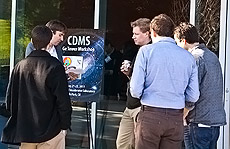CDMS workshop focuses on dark matter detector
 |
|
Dedicated collaboration members continue their work on the Kavli patio during a break. Photo: Lori Ann White
|
More than 50 members of the Super Cryogenic Dark Matter Search collaboration came to SLAC for two days last week to discuss the nuts and bolts of dark matter detection. The goals of the workshop were to close in on an initial design for the dark matter detectors for SuperCDMS-SNOLAB—the version of the experiment to be installed in the SNOLAB underground laboratory near Sudbury, Canada—and to determine what roadblocks may still stand in their way.
"We're trying to get together all the people who are thinking about this to come up with a baseline design," explained Richard Partridge, a SLAC scientist and event co-organizer. "A lot of details go into making one of these work."
That's not surprising, considering what the detectors are trying to detect. The SuperCDMS collaboration aims to find WIMPs—weakly interacting massive particles. WIMPs are one candidate for dark matter, the elusive substance that shapes galaxies through its gravitational effects, but otherwise seems to pass through the dust and gas that makes up the visible universe without leaving a sign.
However, "weakly interacting" doesn't mean "non-interacting." Scientists believe that particles of dark matter occasionally run head-on into atoms of normal matter, but the normal matter is generally so busy interacting with other atoms that it barely feels the collision. This leads to the most essential requirement to make the dark matter detector work: cold. Prior iterations of the CDMS experiment depended on super-cooled disks of germanium to capture the vibrations caused by a single particle of dark matter slamming into an atom of germanium frozen in place by the extreme cold.
"It's particularly challenging working at 50 milli-kelvins," Partridge admitted. "We have to get the detectors so cold and the crystals so quiet that we can cleanly detect that something extraordinary has set the crystal lattice in motion."
SuperCDMS will follow this same approach, but super-size it. The previous CDMS experiment, CDMS II, used 19 germanium disks weighing 0.25 kilograms each; SuperCDMS-Soudan, set to start taking data this summer, will use 15 germanium disks weighing 0.6 kilograms each. In contrast, SuperCDMS-SNOLAB will use about 80 germanium disks containing a kilogram and a half of germanium in each. The experiment will also move deeper underground—from its current 2400 feet under the Earth's surface at the Soudan Underground Laboratory in Minnesota to about 6800 feet below the surface at SNOLAB, in Ontario. The greater depth will better shield the SuperCDMS detectors from cosmic rays which constantly strike the earth. The weakly interacting dark matter is expected to penetrate the 6800 feet of rock between SNOLAB and the surface as though the earth were made of mere gossamer.
"Seven towers, with 12 detectors per tower," Partridge said. "That's the current design—but it may be different by Saturday," when the workshop ended, he joked.
The SLAC CDMS team has already created a prototype germanium detector and is eager to test it. "SLAC is responsible for the payload package" of detectors, Partridge said. "This is the heart of the experiment."
-Lori Ann White
See more from SLAC Today
|